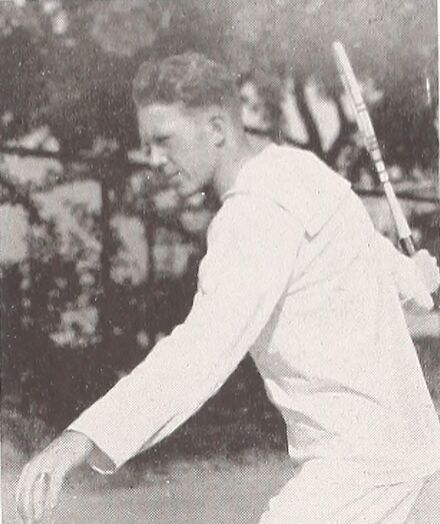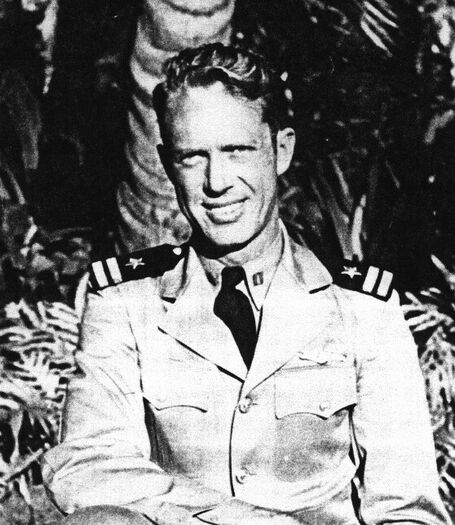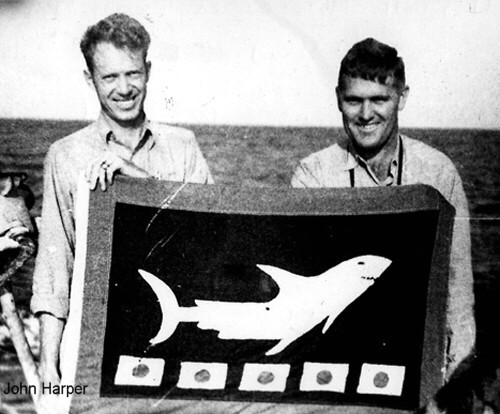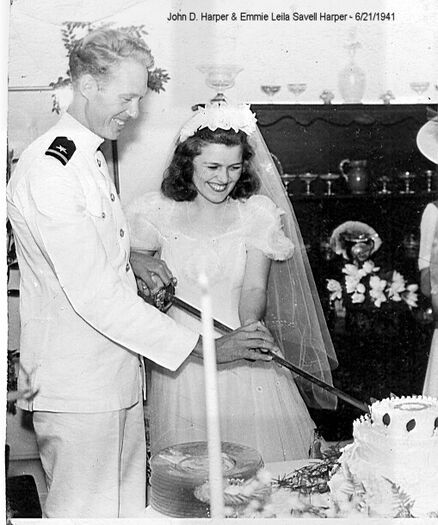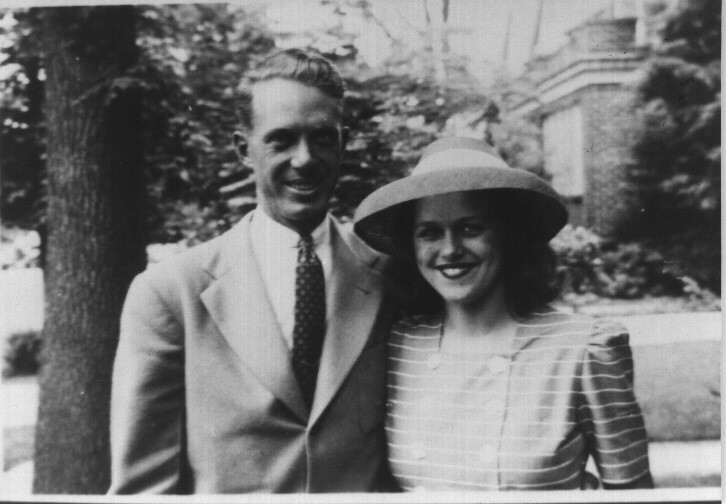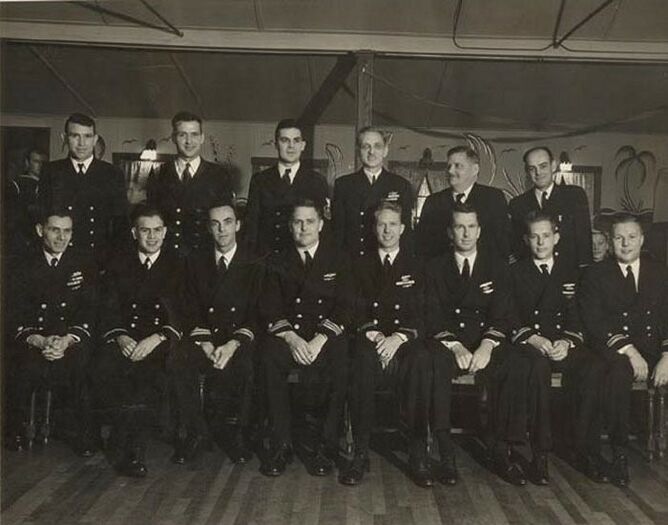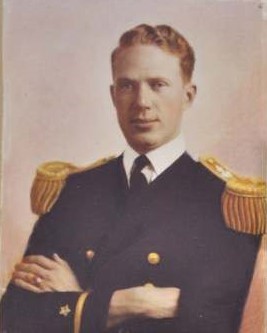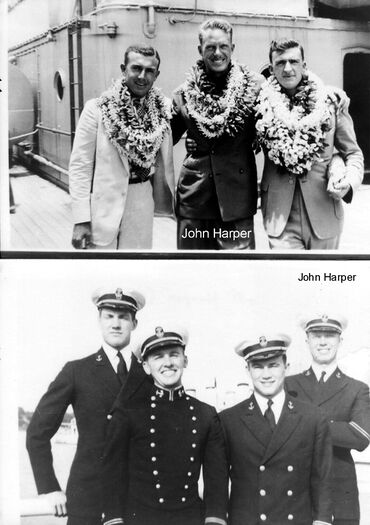JOHN D. HARPER, JR., LCDR, USN
John Harper, Jr. '39
Lucky Bag
From the 1939 Lucky Bag:
JOHN DOTT HARPER, JR.
Trinidad, Colorado
Johnnie, Harp
Although John had to abandon the rod and reel to come to the Academy he still loves to reminisce on the superb trout fishing of his native state. This and tennis occupy his leisure moments; that is, when he isn't dragging or writing letters to his O. A. O. In his work he has the praiseworthy habit of getting the last .01 or good out of the time allotted — if you've ever seen the sweat on his brow at the end of a Nav P-work, you can appreciate the extent of that eagerness. Happy is always to be remembered as the midshipman who openly admitted enjoying the Inaugural P-rade. His excess of optimism has carried him and his friends through many a gloomy Sunday.
Tennis 4, 3; Battalion Tennis 2, 1; Wrestling 4; Battalion Wrestling 3, 2; Musical Club Shows 2, 1; Reception Committee 2, 1; Glee Club 4, 3, 2, 1; Hop Committee 1; Radio Club 1; 1 Stripe.
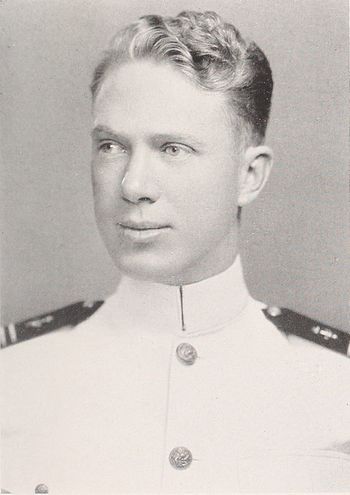
JOHN DOTT HARPER, JR.
Trinidad, Colorado
Johnnie, Harp
Although John had to abandon the rod and reel to come to the Academy he still loves to reminisce on the superb trout fishing of his native state. This and tennis occupy his leisure moments; that is, when he isn't dragging or writing letters to his O. A. O. In his work he has the praiseworthy habit of getting the last .01 or good out of the time allotted — if you've ever seen the sweat on his brow at the end of a Nav P-work, you can appreciate the extent of that eagerness. Happy is always to be remembered as the midshipman who openly admitted enjoying the Inaugural P-rade. His excess of optimism has carried him and his friends through many a gloomy Sunday.
Tennis 4, 3; Battalion Tennis 2, 1; Wrestling 4; Battalion Wrestling 3, 2; Musical Club Shows 2, 1; Reception Committee 2, 1; Glee Club 4, 3, 2, 1; Hop Committee 1; Radio Club 1; 1 Stripe.
Loss
John was lost when USS Shark (SS 314) was sunk by a Japanese destroyer off the coast of Formosa on October 24, 1944.
Other Information
From researcher Kathy Franz:
John was nominated second alternate to the Naval Academy by Senator Adams (D-Colo.)
His father John was a dentist, mother Minnie, and sister Betty.
His wife was listed as next of kin; he was also survived by a son.
Photographs
John, left, with Edward Blakely '34 after their first war patrol. via Heroes of the United States Naval Academy
"Officers and Chiefs of the Shark (SS-314) at the commissioning party, February 1944 at Polly's Inn off West Norwich Road, Montville, Connecticut. Commander Blakely '34 and Lieutenant Harper seated in center of first row." via Heroes of the United States Naval Academy
Remembrances
From "The Voices of Bombing Nineteen":
Our first sign that we were about to be picked up came when some fighters started buzzing us. They dropped a couple of smoke lights to mark us, and we threw dye marker around like mad, me getting most of it on myself. The sub finally came into view, and what a beautiful sight it was! Harvey and I almost fell overboard trying to wave at it. After a little trouble we got aboard OK, and what a comfortable feeling that is!
So help me, these sub boys are the tops. Nothing is too good for you when you come aboard under our circumstances. We got a hot shower, clean dry clothes, cigarettes, coffee, hot soup, etc. All we had to do was name it, and we could have it. After being introduced all around and trying to put something in my stomach (which wouldn't stay), I hit the sack. Harvey did the same aft in the men's quarters. When I woke up it was time for chow, so I tried it again, and it stayed down this time. By the way, their food is the tops. After having a little more bull session, the topics being planes and subs, I hit the sack for good that night, winding up what I would call a "rather full day".
5 August 1944 - I wandered around the ship wondering what all the gadgets were. I got the word on the general run of the ship from one of the officers who took me on a sightseeing tour. We had to make several dives that day and night, just because some "fly-fly boy" (the sub boys' pet name for us) forgot his "trigger". We were still playing lifeguard and went hunting for one of our planes that was forced down - no luck, though.
The chow on these boats amazed me more every time we ate. I was up on the bridge for a few minutes and later had my first look through a periscope. We had to make a couple of fast dives that night - bogies, I guess. I hit the sack about 10 PM to wind up my first full day aboard one of Uncle Sam's subs on patrol.
6 August 1944 - I woke up about 0700, just in time to have breakfast with the Skipper, who, by the way, is one hell of a swell guy. After that I went up in the conning tower to see what was going on. They let me take the helm for about a half hour, but that's enough said about that, because the wake, after I got through, looked like the trail of a snake with a broken back. I then had a long look through the periscope at "my island". For some reason, it still looked rather innocent. My thoughts about its innocence had another rough jolt when right in the middle of lunch a couple of Hamps or Zeros slipped up close on us before we saw them. Our lookouts saw them in time, however, for us to get pretty well below the surface with a fast dive before they could drop their depth charges. They dropped them just the same, though. Three of them went off - WHAM! (pause) WHAM! WHAM! It happened so fast it was over before I realized what had happened. There was no damage, however, and it didn't seem to impress anybody very much. I don't mean that these guys like to get dropped on, but I guess one can get accustomed to most anything. Not five minutes after this happened, somebody suggested a poker game, so I joined all the officers who were not on duty and got wound up in the pasteboards. I proceeded, as per my usual game, to lose $6.50. This broke up before chow, so this gave me time to wash up and shave (?) I shaved for my first beard that day. It was only a few days gone, but it promised to look pretty sharp in about a month.
Back to this subject of chow - that word "chow" is a masterpiece of understatement. It's like eating at your favorite restaurant every meal.
That night we had roast chicken, mashed potatoes, carrots and peas, gravy, olives, coffee, and, last but not least, the best ice cream I'd had since I left the states. Pineapple was the flavor, and was it good! After dinner we went to "darken ship". That means that all white lights are turned out and there is nothing but red ones on. This is done so they won't be blind when they go up on the bridge for their watch.
I've noticed a few little things. First, the uniform - it's great - shorts and a "T" shirt. That's it for everybody, from the Skipper to the lowest rated man in the crew. Second, sleeping - there doesn't seem to be any regular hours for it. Everybody seems to sleep when there isn't anything else to do or when they are not on watch.
7 August 1944 - I woke up about 0700 to start a very quiet day. It was getting so that I woke up automatically at this time every morning, just in time for breakfast. I sort of had to get up, though, because my sack was just about one-half of all the seats in the wardroom. After breakfast the Skipper and I played a game of Gin Rummy. I managed to win from him, too. I had a very close look at one of the Japs' "unsinkable" aircraft carriers through the periscope. If there had been any Jap wahinies on the beach we would have been able to see them. We sure as hell were close enough. This was the first day since I had been aboard that they hadn't been looking for some more "zooms" like me to fish aboard. We were strictly on the hunt that day. After noon chow (which was good as usual), I hit the sack for a couple of hours since there was nothing much else to do. We submerged about 0230, and at about 1900 we surfaced. At 2230 I was up on the bridge. I noted: "There is almost a full moon and the sky is as clear as a bell. Our course right this minute is right up the moon path. There's a slight breeze which makes it just about perfect. (Perfect is right, just about right for one of those little bastards to slip up on us.) I think the general opinion is that it's a hell of a night to fight a war. It's about time I hit the hay for a little shuteye."
8 August 1944 - One of the Japs' fly-boys pulled a very dirty and unethical trick. It was strictly not according to Hoyle. The Japs, being very cagey and observing, noticed that when one of our flyers is floating in his little rubber boat in this big ocean at night, he proceeds to let anybody know where he is by shooting a certain color flare. Well, the slant-eyes figured this was a good chance to get a shot at one of our subs or anybody who came around hoping he can do his good deed for the day by dragging some poor devil out of the drink. So they dropped a few flares from a plane every now and then and then moved off a little way and waited developments. This is just what happened. Naturally, when our lookouts spotted the flare, we started towards it, knowing full well it could be a trick, but that didn't seem to bother these sub-boys. I guess they figured there just as well could be somebody out there, and they were going to find out if there was - and if not, who in hell was yelling "wolf"? Well, a Jap plane jumped us, but we dove away from him with no trouble, except that the diving horn woke me up. "Tsk, tsk - no manners, these Japs". The Skipper also has his own name for them. To quote, "(censored)", unquote!
NOTE: The above was written aboard the USS Shark. After spending a month aboard, plus a wonderful two weeks leave with the crew of the U.S.S. Shark at the Royal Hawaiian Hotel, arranged by the Skipper, I never saw them again. The U.S.S. Shark II (SS-314) was reported overdue and presumed lost with all hands as of 24 October 1944. Bill Emerson
Silver Star
From Hall of Valor:
The President of the United States of America takes pleasure in presenting the Silver Star to Lieutenant John Dott Harper, Jr. (NSN: 0-82437), United States Navy, for conspicuous gallantry and intrepidity in action while serving aboard the U.S.S. DRUM (SS-228) during World War II. During four extensive War Patrols in enemy waters and despite determined enemy opposition he courageously and skillfully performed his duties as First Lieutenant and Damage Control Officer of a United States Submarine and thus assisted materially in the sinking of an important amount of Japanese shipping. His excellent judgment and coolness under fire contributed in a large measure to the success of the ship. His conduct throughout was in keeping with the highest traditions of the United States Naval Service.
General Orders: Commander in Chief Pacific: Serial 33
Action Date: World War II
Service: Navy
Rank: Lieutenant
Company: First Lieutenant
Division: U.S.S. Drum (SS-228)
From Hall of Valor:
The President of the United States of America takes pride in presenting a Gold Star in lieu of a Second Award of the Silver Star (Posthumously) to Lieutenant Commander John Dott Harper, Jr. (NSN: 0-82437), United States Navy, for conspicuous gallantry and intrepidity in action in the performance of his duties as Assistant Approach Officer in the U.S.S. SHARK (SS-314), during the FIRST War Patrol of that Submarine from 16 May 1944 to 17 June 1944. His ability to furnish his Commanding Officer with a continued flow of valuable information contributed directly to the sinking of four enemy ships totaling 32,200 tons and damaging an additional enemy ship of 5,600 tons. His efficiency and coolness during severe enemy countermeasures greatly assisted his ship in conducting successful evasive tactics. His conduct throughout was an inspiration to the officers and men in his ship and was in keeping with the highest traditions of the United States Naval Service.
General Orders: Commander in Chief Pacific: Serial 06666 (November 17, 1944)
Action Date: May 16 - June 17, 1944
Service: Navy
Rank: Lieutenant Commander
Company: Assistant Approach Officer
Division: U.S.S. Shark (SS-314)
The "Register of Commissioned and Warrant Officers of the United States Navy and Marine Corps" was published annually from 1815 through at least the 1970s; it provided rank, command or station, and occasionally billet until the beginning of World War II when command/station was no longer included. Scanned copies were reviewed and data entered from the mid-1840s through 1922, when more-frequent Navy Directories were available.
The Navy Directory was a publication that provided information on the command, billet, and rank of every active and retired naval officer. Single editions have been found online from January 1915 and March 1918, and then from three to six editions per year from 1923 through 1940; the final edition is from April 1941.
The entries in both series of documents are sometimes cryptic and confusing. They are often inconsistent, even within an edition, with the name of commands; this is especially true for aviation squadrons in the 1920s and early 1930s.
Alumni listed at the same command may or may not have had significant interactions; they could have shared a stateroom or workspace, stood many hours of watch together… or, especially at the larger commands, they might not have known each other at all. The information provides the opportunity to draw connections that are otherwise invisible, though, and gives a fuller view of the professional experiences of these alumni in Memorial Hall.
October 1939
June 1940
November 1940
April 1941

The "category" links below lead to lists of related Honorees; use them to explore further the service and sacrifice of alumni in Memorial Hall.
